
Terraced Yard Tips, Tricks, Ideas & All You Need to Know
Published: 14/11/2022 | Updated: 29/03/2023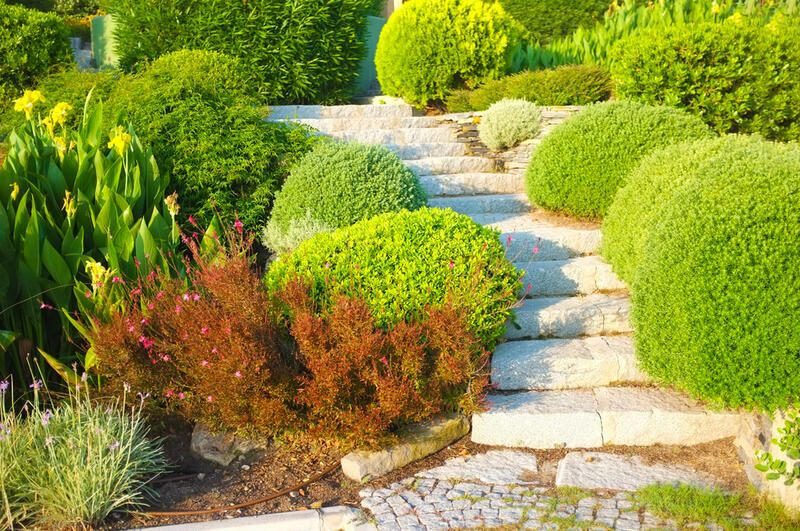
Do you have a garden that is uneven and steep? Perhaps your house is in a hilly area? By organizing and leveling that steep slope into terraces, you may create a distinctive outdoor living area. Simply put, a terraced garden is a collection of miniature gardens on various elevations that not only enhance its aesthetic appeal but also aid in preventing erosion.


There are numerous landscaping options for sloping hills and terraced backyards that improve home designs, provide lovely outdoor living areas and raise property values. Softly sloping hills might be difficult to deal with, but persistence and imaginative backyard landscaping ideas that blend in with the environment transform outdoor living areas into stunning gardens and places to unwind and connect with nature in an opulent and delightful style.
When it comes to planning your terrace garden design, there are several factors you're going to want to keep in mind and some ideas on how to personalize your terrace garden to help you transform your garden into a backyard wonderland throughout the seasons! Let's get right into it!
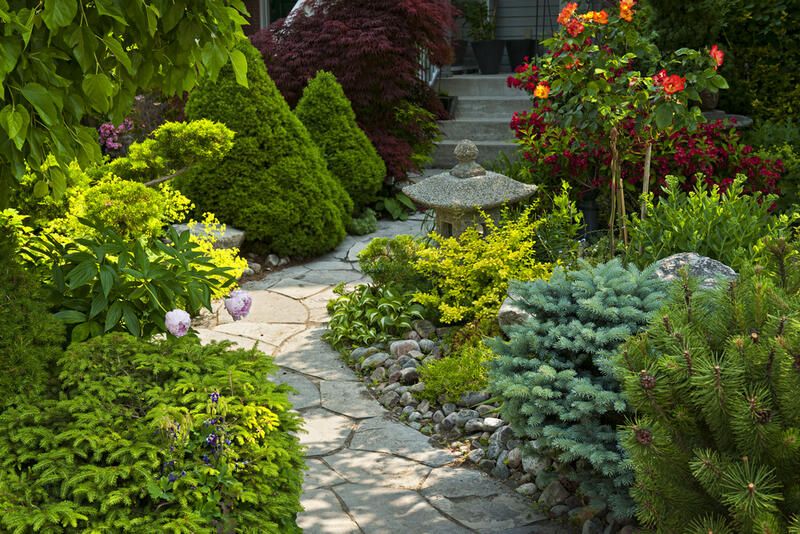
What is a Terraced Garden?
There are two types of gardens that might be referred to as "terrace gardens." A terrace garden can be defined as a garden that is developed on a terrace box, a rooftop terrace, or a patio, typically in a home with little outdoor space for gardening. Urban regions are where these kinds of gardens are most prevalent, though they can also be found in some restaurants and other businesses. A garden that is constructed against a hillside in a succession of raised or "terraced" beds is also referred to as a terrace garden. There are several really old terrace garden examples in South America and Asia. Terrace agriculture is frequently the only way to utilize steep ground.
A patio or a rooftop garden are examples of terrace gardens. They can be decorative or practical, and they are typically created with container plants to make the terrace easier to maintain. On their terraces, gardeners can construct raised beds for growing their crops. The purpose of the garden should be taken into account when establishing it, as should water availability and sun exposure.
On their terraces, some homeowners like growing fresh herbs and vegetables, while others seek to create a peaceful sanctuary. On occasion, gardeners will combine the two. For privacy or shade, plants can be trellised around a terrace. They can also be employed to create a relaxing outdoor space for the home's occupants and visitors. Due to space restrictions, it pays to plan while creating this type of garden.
In a different meaning, a terrace garden can be utilized as a decorative element in landscaping, a technique to transform a landscape so that it can be used for gardening, or as a place to grow to produce. By leveling portions of a slope and erecting retaining walls, terrace gardens are created. A raised terrace can be built by gardeners by backfilling an area bordered by a retaining wall. This style of terracing requires excellent drainage. By splitting rugged terrain into smaller, level portions where water is more easily distributed and absorbed into the ground, terrace gardens aid in the prevention of erosion. A terrace hillside garden can make a beautiful addition to the landscape and can be filled with a wide range of annuals, perennials, and creeping shrubs that are evergreen.
You can still create a terrace garden in situations without hills in the surrounding terrain. Some individuals prefer terraced landscaping because it adds interest and vitality to the surroundings. Terraces are made by trucking in gravel for drainage and soil for growing, then building a series of terraces and retaining them with brick, concrete, or wooden walls. This garden can be grown in many different ways once it is established, and visitors frequently pay close attention to it.
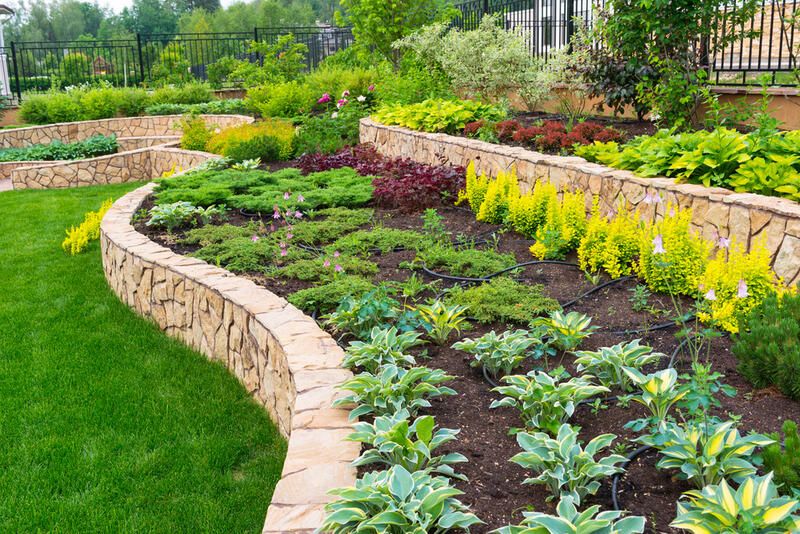
Things to Know About Creating a Terrace Garden
As we previously mentioned, if your backyard has a hillside, you may have difficulties with soil erosion and limited room for gardening. Terracing is a useful technique for transforming hillsides into workable plant plots. Terraces, which resemble a wide stairway, enable you to have many levels of planting beds on the slope to increase the total amount of backyard space. Plan your terraced yard taking all the variables into account. But how does terracing affect your backyard or what do you need to know before investing in a terrace garden? Let's talk about it!
Smaller Terrace Gardens
A modest terrace shape is one of the simplest ideas to put into practice. For each terrace level, you just need to cut and fill the soil behind the short partition using wall materials that are less than 2 feet tall. Typically, you dig a trench big enough to hold the landscaping lumber that will serve as your base wall material. A short but sturdy retaining wall is made by joining the base wood with one or two additional timbers. The soil behind the wall just has to be leveled using a shovel and a hand level as you move the soil about.
Larger Terrace Gardens
A landscape engineer is typically required to calculate the soil weight and wall strength for terraces with walls that are more than 2 feet in height. There cannot be a simple wall and soil arrangement on these terraces. At the base of each terrace, for instance, landscape fabric containing gravel for water drainage is required; topsoil is located above this arrangement. For the fabric and gravel arrangement to stay upright against the heavy soil and in the event of an earthquake, the wall itself must be inclined inward by 1 inch at every 1-foot height in addition to installing a drainpipe.
The Pros of Terrace Gardening
There are various advantages to terracing your backyard that over time help you save money. A properly constructed terrace has a little surface slope, which directs water to the sides and out to neighboring drains. As a result, your home's foundation is shielded from continuous water flow that could harm the building's concrete or wooden foundation. Because water does not flow down the formerly inclined hillside, the terraces also prevent soil erosion. Additionally, you acquire garden space for crops like strawberries and tomatoes that might feed your family, saving you money at the grocery store.
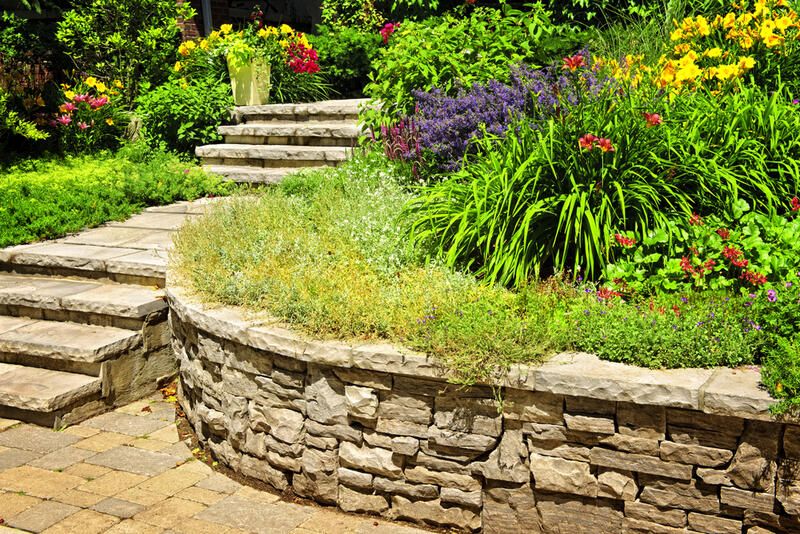
Safety Precautions & Challenges
There are some limitations to designing a garden on a hill. You won't be able to haphazardly begin cutting into the slope or uprooting already-existing trees and vegetation. Who likes mudslides? Careful planning is required to prevent harming the integrity and stability of the site. Consider the placement of retaining walls and a planting design that is appropriate for the hilly area.
You should add plants that can handle moister soil near the bottom of a slope where moisture tends to collect after rain. You'll add more dry-tolerant plants at the top. To aid in stability, always opt for deep-rooting plants. Soil is better anchored by using groundcovers and rocks. Additionally, planting trees that develop a network of roots aids in tying and bolstering the levels. Get a free phone consultation from the professionals at Shrubhub.com for assistance with your garden design.
Once you've chosen a terracing technique, it's critical to confirm the locations of any power, gas, sewage, and phone lines. You must avoid damaging any of these while you construct your terraces. To prevent landslides while working on the hillside during terracing, you must also remove soil in tiny batches. Before beginning a project, always check the building codes to make sure you have the required permissions.
The Fun Part: Terraced Yard Ideas for Designing
You essentially double the amount of space available by converting a slope into a terraced garden. You can play around with levels in a dynamic, three-dimensional manner. The area gains a lot of character when a network of connected, multi-level garden beds is designed. The end effect can be a stunningly dramatic garden with an amphitheater-like atmosphere.
This implies that you can designate distinct areas for different uses, such as decks or patios, benches, a bonfire area, ponds, and pools, as well as firepit seating. So, let's get started and examine some suggestions for building a stunning multi-level terraced garden that is dramatic in appearance and gorgeous in spirit!
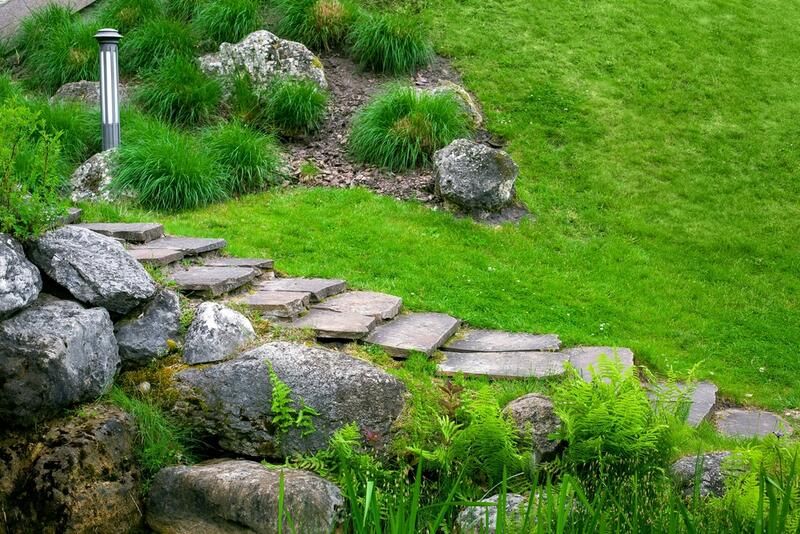
Planting & Farming
Regardless of where you are, planting the elements is always a must! Whether you decide to go full terrace farming with different vegetables and create a multi-level produce hub or a perennial and flora haven, making sure you choose the right plants for you is always important.
Deciding what level of maintenance is desirable, what color palette matches your aesthetic and landscape, checking your soil levels, seeing how much sun hits the area, and figuring out what plants work in your climate are all the necessary steps for farming or planting your terrace garden. Make sure your plants are sturdy to last the many seasons to come!
Once you nail down those fundamental factors, it gets a lot easier, and a little creativity can go a long way!
Deciding what flowers you want, the type of vegetable garden you want to incorporate, what your first tier will look like versus your last, whether or not you want to add small containers for farming or a few small trees for the garden area, and even more ideas! The ideas never start because once the logistics are out of the way, the fun part starts!
Rounded Shapes & Organic Forms
Adding landscape timbers or treated wood for decking to your terraced garden levels? Curved decking stays true to the land's and space's natural contours. This will maintain your terraced garden looking distinct while allowing it to still look as though it belongs in its surroundings.
Utilize the Space
It maximizes the planting area to have multiple layers. For a clean appearance, go for well-organized layers of dense plantings in a coordinating color scheme. Have a garden that is three layers deep? A cascade of water features and flora should be in the center, with chalk stick succulents at the top, and a tall cardboard palm should be at the base to add height. It's all about making sure your sloping garden is as visually pleasing as it is relaxing!
Add Grass to Your Terrace Garden
In a terraced garden, ornamental grasses appear lovely as they move and sway in the breeze, the more layers, the better. The strong features of the structures are softened by overlapping terraces filled with low-maintenance plants and grasses. Additionally, they offer relaxing hypnotic movement.
Compliment Your Existing Aesthetic
Keep the indoors connected to the outside by building the retaining walls of your terraced garden out of the same materials as your home.
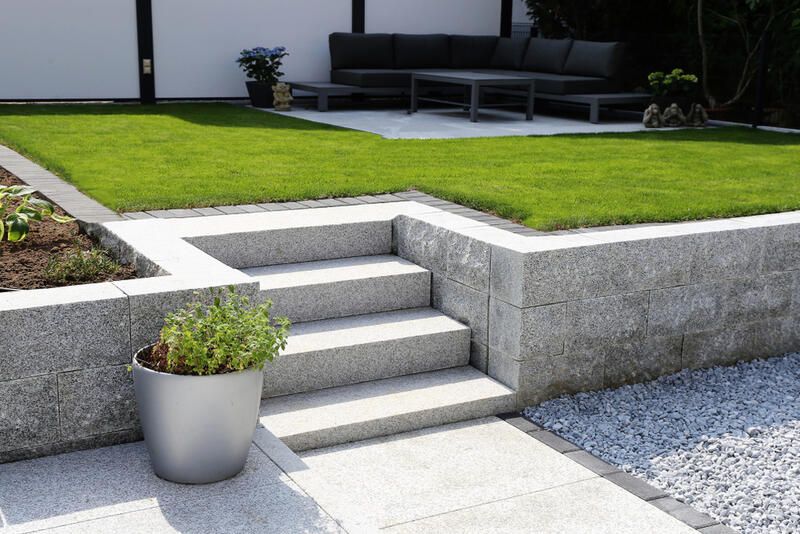
Water Features for the Win
Water features often provide aesthetic appeal to a landscape, but terraced gardens benefit greatly from their use. Small fountains or waterfalls go well with the idea of a slope. Water trickling downhill due to gravity just feels natural. Even better, consider integrating your water feature with your irrigation and drainage setup.
To Step or Not to Step
Authentic, traditional terraced gardens frequently have multiple steps or stairs with different angles. This is done to facilitate traveling through various environments. Think about what you need: do you want to stroll through your garden or just observe it from a distance? Do you require access for repairs? You can use this to determine whether you need to add more stages.
Create Different Zones
You have the option to integrate small social spaces on various levels in addition to gardens in your terraced garden. One benefit of working with terraces is that you can design all those distinct zones that give the area its functionality and vibrancy. For instance, to create a dining set that is an attractive addition, you might include banquette seating along textured stone walls. Or, for chilly nights or winter parties, have a place to warm up outside. Here are some of my favorite outdoor fire pit designs for you. Try out different patio and outdoor dining ideas to complement your natural surroundings.
Clean Lines
Have parallel tiers if you like a clean, linear appearance. A series of horizontal parallel lines are produced by tiers produced by stone retaining walls or rows of trees and hedges in a terraced garden. These have great aesthetic appeal.
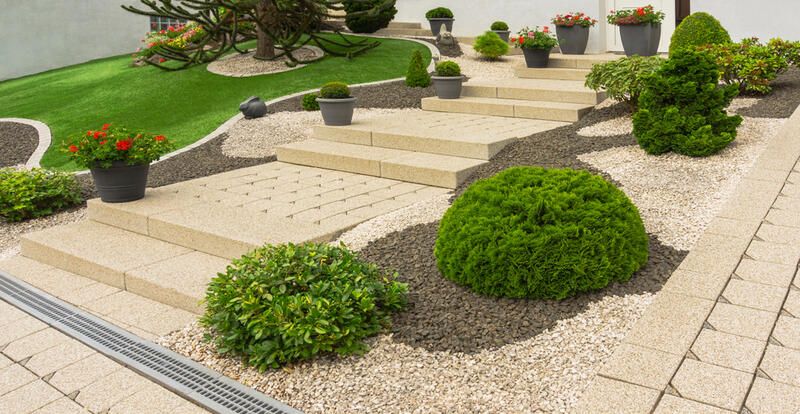
Create Different Directions
As you move through the stages, think about including tiny steps that change direction. In a tiny, terraced garden, it creates a dynamic and captivating arrangement. Steps with an irregular bend are both aesthetically beautiful and safer than ones with a sharp straight up and down the slope.
Bring On the Light
Make your lovely, terraced garden stand out with creative landscape lighting. It could be wall or solar lights, garden lanterns, or a gorgeous light string. In either case, adding illumination will give your levels depth and draw attention to your standout plants.
Steps can be made safer by using lighting, such as recessed LED strips, to assist make it clear where levels change. Talk to a knowledgeable landscape lighting designer to develop a strategy for your garden's requirements. Shrubhub.com offers full 3D design and lighting plans so we recommend checking them out now for a 70% discount!
Adding Planters
A structured terraced garden's harsh lines will be softened by other plants in pots or boxes. You could even use big planters and additional soil to create a mini centerpiece garden with different flora from its surroundings
The Wonders of Visual Tricks
A terraced garden not only has additional area due to the levels. However, you might also benefit from visual tricks that amplify the impression of spaciousness. A terraced garden might appear to have much more depth and space than it has through skillful landscaping. Combining textured plantings with a meandering route can provide dimension.
Bring Back the Classics
A traditional terraced garden design that allows for easy access to all garden levels features symmetrical garden beds on either side of a flight of stairs. See also our article with fantastic, raised garden bed ideas if you'd like some inspiration for various styles of raised garden beds.
Watering Needs
Your terraced garden's upper levels can be there only for aesthetic appeal. In that situation, establishing an irrigation system is the way to go because it can be difficult to hand-water plants in the highest areas. Fortunately, terraced gardens with drip watering systems can benefit from natural gravity.
Continuity
Consider continuity when designing a tiered garden so that your internal and outdoor aesthetics are consistent. This contributes to extending the living room outside of the actual house for a unified aesthetic. Colors, textures, and even the type of furniture you use can be used to tie the two spaces together.
Natural Materials for a Natural Look
Rocks and boulders are only a couple of the materials you might use to build terraces. Limestone rock miniature retaining walls can be used as dams. One of the key benefits of terracing is that it will catch rain, preventing soil erosion.
Beauty of Simplicity
It's simple to stop erosion in a sloped front yard by building a basic two-layer retaining wall. The slope is changed into a series of softer steps, preventing the rain from rushing off. Select a stone with an appealing texture that goes well with the façade of your house. Add a focal point for visual attraction. You won't need to spend as much time weeding the front yard if you pick resilient, low-maintenance plants that will outcompete weeds. Alternatively, employ someone else to maintain your garden!
Structure, Structure, Structure
Retaining walls provide structure and order, while terracing transforms a run-down steep hillside into a streamlined contemporary design. There are so many different styles and materials available for retaining walls. Your decision will be influenced by the requirements of the site, your preferences, and other factors. Typical building materials include wood, stone, brick, and concrete.
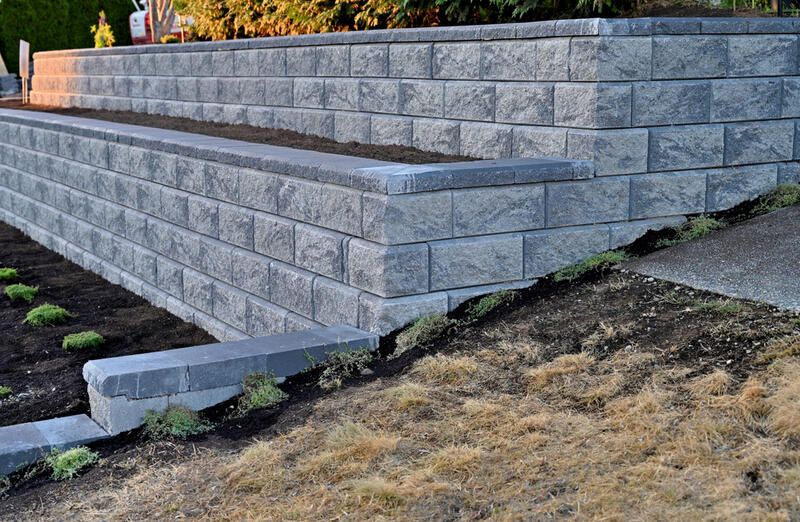
Functional Yet Aesthetic
In gardens with steep terraces, natural stone retaining walls have the additional advantage of serving as a neutral backdrop for showy plants. A planting is significantly broken up by contrasting colors to showcase the primary plants. For instance, seaside flora complements a limestone retaining wall beautifully. Additionally, this will aid in shielding a coastal home from strong winds.
Add Pops of Color
You might like to go with a succulent planting and a sea of blues and greens. Or maybe a pleasing soft color scheme with pink and lavender flowers. Why not consult a garden planting specialist who can help you realize your idea if you have a certain color scheme in mind?
Try Different Shapes
Instead of building retaining walls, you can change a site's contours by raising soil in gentle mounds. An established site's form can also be changed by adding new components like large granite steps or bluestone steppingstones.
Terrace Trees
Considering whether to remove mature trees is a smart idea depending on how you organize your terraced garden and how you evaluate the elements already there. The integrity of your site might be impacted by ground movement. A garden that has been terraced around a tree can also be quite attractive.
Terrace Pools
A contemporary terraced backyard's various levels and elements are kept connected by the use of the same materials repeatedly. Have a pool, for instance, in your terraced garden? Match the decking's wood color to that of your steps, benches, or even Adirondack chairs.
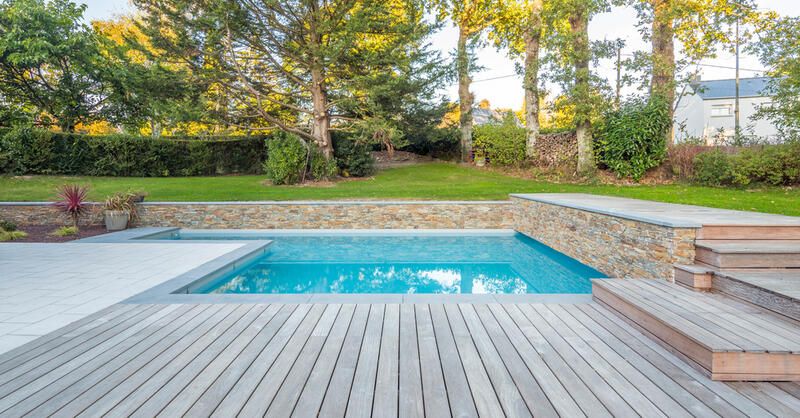
Stone Pathways
Combining the beauty of your backyard's natural surroundings with a sloped stone pathway is add a charming look. Add some bright sunflowers and blooming shrubs for contrast and you've successfully replicated the entrance to Eden's garden!
DIY Sloped Water Feature
You can of course add a pond or bird bath to your terrace garden design but what if you could make your waterfall? How about you create one using old watering spouts from your garden? Placing them one above the other on steps and having a water hose run through it can create a beautiful cottage core look that everyone will adore!
Terrace Garden Seating Deck
We love outdoor seating, especially outdoor seating surrounded by large trees, flowers, and the contrast of dividing hilly areas! Creating an elevated seating deck on your terrace garden is a sight not to miss. Add a few of your favorite throw blankets and pillows! Get the tea ready for your new perfect morning reading nook!
Tropical Wonderland Garden
Just because you're in your backyard doesn't mean you can't enjoy a tropical getaway. Plant a few palm trees and drench the bottom of your sloping garden with sand right before your pool for a resort vacation right in your backyard. Throw in some flora and you've won the summer.
Trail of Flowers
Nothing compliments the vertical distance of your sloped terrace garden like a trail of vibrant flowers flushing left and right. Add your favorite in-season perennials and you've created an unimaginable focal point for your garden!
Mixing Shrubs & Flora
Last but not least, disregard regularity and order; how about a riotous explosion of color encircling your rocks or steps? It has a beautiful, romantic look. Try mixing different shrubs and flora with boulders and rock for a cottage-like beauty.
What Should I Plant in My Terrace Garden?
When planting on a slope, keep in mind that soil and water retention may be different from flat land. The soil's nutrients could wash out and the sloped land could dry out more quickly.
Look for plants that will firmly anchor themselves to the ground and have a strong root system. In times of intense rainfall, the deep roots will keep them in place and prevent soil erosion.
On sloped soil, perennial plants perform better than annuals because they offer year-round ground cover. The edible perennials like globe artichokes that are interplanted with herbs and little fruit bushes are my favorites.
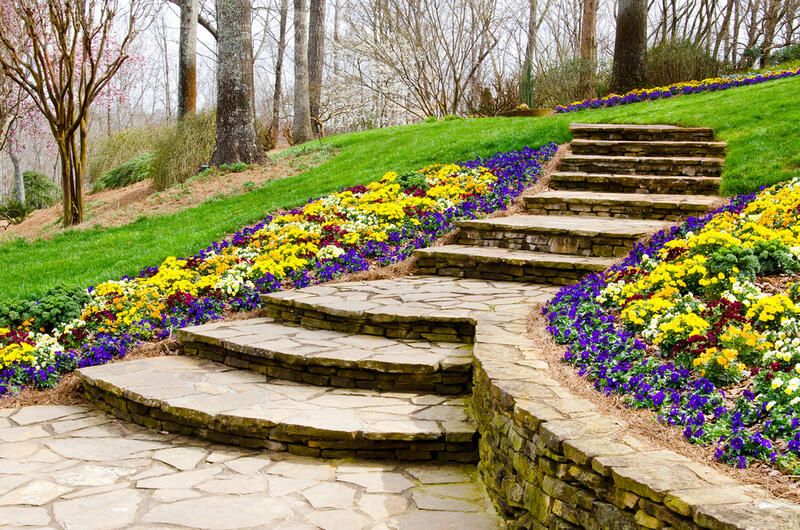
How to Avoid Erosion
When planting on a slope, keep in mind that soil and water retention may be different from flat land. The soil's nutrients could wash out and the sloped land could dry out more quickly.
Look for plants that will firmly anchor themselves to the ground and have a strong root system. In times of intense rainfall, the deep roots will keep them in place and prevent soil erosion.
On sloped soil, perennial plants perform better than annuals because they offer year-round ground cover. The edible perennials like globe artichokes that are interplanted with herbs and little fruit bushes are my favorites.
Create Your Own Terrace Garden Design
There are a million and one ways to customize and design your backyard terrace garden. From vegetable gardens in Atlanta to modern clean lines in San Francisco. You'll always find something to create.
The steep slopes will no longer halt your creativity, buy those concrete blocks and create your stepping stones. Use landscape timbers for decking. Just take your slope horizontal measurement and go from there! Design everything from the first tier to the first trench, go all out and match your indoor artwork, outside.
Define your space with your terrace gardening and transform that steep hill into whatever you want it to be!
We can't wait to see how you let your creativity run free. If you ever feel like you could use some planning help, check out Shrubhub.com for the expertise and 3D designs!


